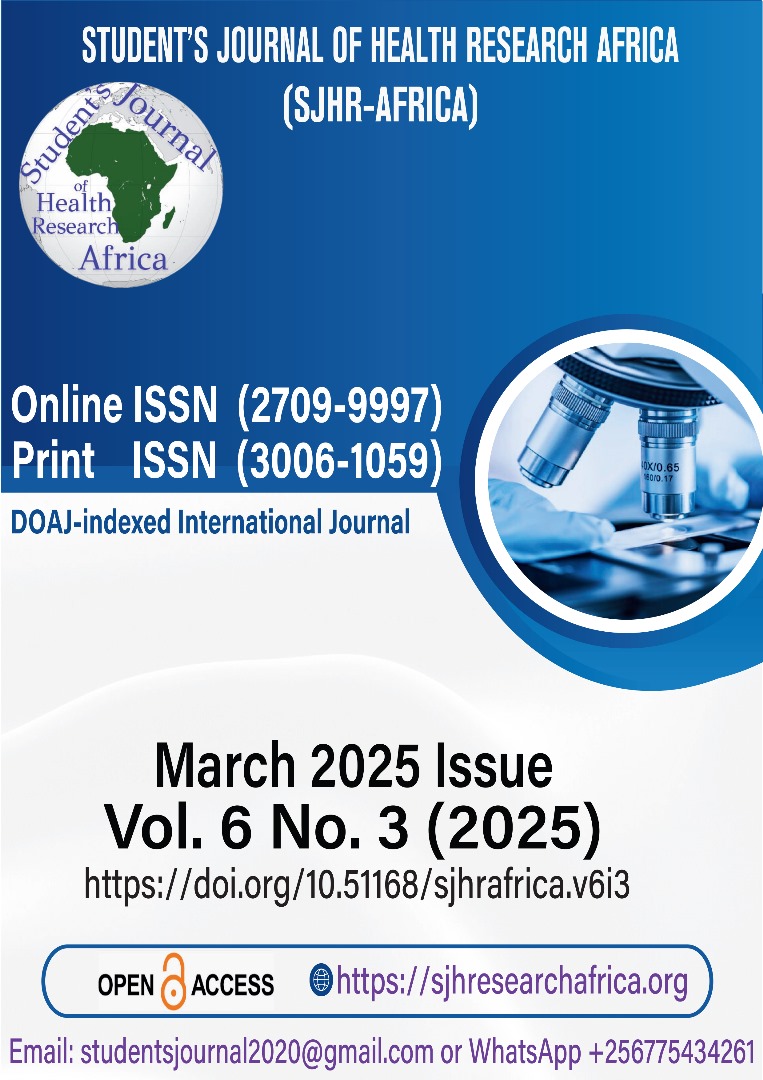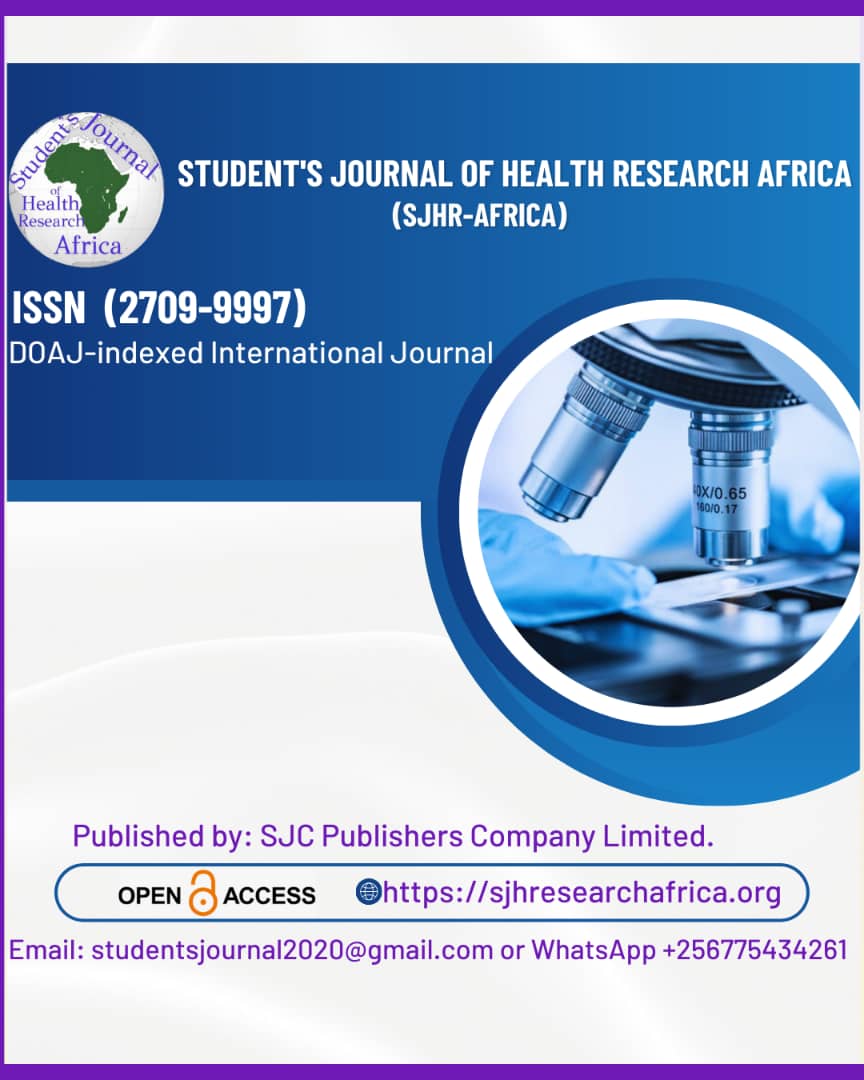Ultrasonography and Pregnancy Outcome in Threatened Abortion: A Prospective Observational Study
DOI:
https://doi.org/10.51168/sjhrafrica.v6i3.1660Keywords:
First-trimester ultrasound, fetal heart rate, crown-rump length, pregnancy outcomes, preterm birth, intrauterine growth restrictionAbstract
Background: Threatened abortion, marked by first-trimester vaginal bleeding, poses a risk for pregnancy loss and adverse outcomes. Ultrasonography is a key diagnostic tool for assessing fetal viability and identifying predictive markers such as fetal heart rate and crown-rump length. This study explores the role of ultrasonographic parameters in predicting miscarriage risk and guiding clinical management.
Methods: This prospective observational study encompassed 100 pregnant women categorized into three groups based on first-trimester bleeding and ultrasonographic findings. Transvaginal ultrasonography assessed fetal heart rate, cervical length, and gestational sac characteristics. Statistical analyses evaluated the predictive value of sonographic markers for pregnancy outcomes.
Results: Baseline characteristics were comparable among groups, but Group I had earlier and heavier bleeding. Group I also revealed lower fetal heart rates and crown-rump lengths, indicating poor pregnancy viability (p < 0.05). Adverse maternal and neonatal outcomes, including PROM, IUGR, and NICU admissions, were more frequent in Group II (p < 0.05). Early abnormal ultrasound markers were significantly associated with late pregnancy complications.
Conclusion: Early first-trimester ultrasound markers, particularly fetal heart rate and crown-rump length, are strong predictors of adverse pregnancy outcomes. Identifying these markers can aid in risk stratification and timely intervention.
References
M. R, G. A. A prospective observational study on pregnancy outcome in women with threatened miscarriage in a tertiary care centre. J Evol Med Dent Sci. 2021;10(45):4003–4008.
Mahadik K, Choudhary P, Roy PK. Study of thyroid function in pregnancy, its feto-maternal outcome; a prospective observational study. BMC Pregnancy Childbirth. 2020;20(1).
Badugu RB, Kodey P, Pappala S. Evaluation of outcome of pregnancy complicated with thrombocytopaenia: a prospective observational study. J Clin Diagn Res. 2022.
Rajendran, Parikh R. A prospective and observational study on fetomaternal outcome in postdated pregnancy. Int J Med Biomed Stud. 2020;4:10.
Ghosh M, Mandal AK, Seth S, Naskar A. Fetomaternal outcome in patients with threatened abortion in the first trimester – an observational study. Asian J Med Sci. 2022;13(3):152–157.
Sakran R, Shechtman S, Arnon J, Diav-Citrin O. Pregnancy outcome following in-utero exposure to ondansetron: a prospective comparative observational study. Reprod Toxicol. 2021;99:9–14.
Pleasant EA, Cartwright AF, Upadhyay UD. Association between distance to an abortion facility and abortion or pregnancy outcome among a prospective cohort of people seeking abortion online. JAMA Netw Open. 2022;5(5).
Kumari P, Wanjari S. Comparison of transvaginal colour Doppler ultrasound and progesterone level estimation in outcome of threatened abortion in early pregnancy. J Clin Diagn Res. 2020.
Acharya T, Gohain BS, Morang K. Pregnancy outcome in a bicornuate uterus with bilateral pregnancy presenting as threatened abortion: a case report. Int J Reprod Contracept Obstet Gynecol. 2021;10(11):4334.
Chowdhury DS. Successful pregnancy outcome after laparotomy (a case of pregnancy with ovarian tumour). J Med Sci Clin Res. 2020;08(02).
Lee SE, Bae YK. Breast lesions during pregnancy and lactation: a pictorial essay. Ultrasonography. 2020;39(3):298–310.
Bon GG, Kenemans P, Dekker JJ, Hompes PG, Verstraeten RA, et al. Fluctuations in CA 125 and CA 15–3 serum concentrations during spontaneous ovulatory cycles. Hum Reprod. 1999;14:566-570.
Leylek OA, Senocak F, Erselcan T. The prognostic predictive value of maternal serum CA 125 levels in threatened abortion. Int J Gynecol Obstet. 1997;59:147-149.
Datta MR, Raut A. Efficacy of first-trimester ultrasound parameters for prediction of early spontaneous abortion. Int J Gynecol Obstet. 2017;138:325-330.
Dede FS, Ulucay U, Kose MF, Dede H, Dilbaz S, et al. Fetal loss in threatened abortion after demonstration of fetal cardiac activity in a low socioeconomic population. J Obstet Gynecol. 2010;30:622-625.
Chitacharoen A, Herabutya Y. Slow fetal heart rate may predict pregnancy outcome in first-trimester threatened abortion. Fertil Steril. 2004;82:227-229.
Wie JH, Choe S, Kim SJ, Shin JC, Kwon JY, et al. Sonographic parameters for prediction of miscarriage: The role of 3-dimensional volume measurement. J Ultrasound Med. 2015;34:1777-1784.
Bamniya J, Panchal D, Singh P, Shah A, Ladola H, et al. Early sonographic markers and prediction of pregnancy outcome: a prospective study. Int J Reprod Contracept Obstet Gynecol. 2017;6:2471-2484.
Oh JS, Wright G, Coulam CB. Gestational sac diameter in very early pregnancy as a predictor of fetal outcome. Ultrasound Obstet Gynecol. 2002;20:267-299.
Tan S, Tangal NG, Kanat-Pektas M, Özcan AŞ, Keskin HL. Abnormal sonographic appearances of the yolk sac: which can be associated with adverse perinatal outcome? Med Ultrasonography. 2014;16:15-20.
Abuelghar WM, Fathi HM, Ellaithy MI, Anwar MA. Can a smaller than expected crown-rump length reliably predict the occurrence of subsequent miscarriage in a viable first-trimester pregnancy? J Obstet Gynecol Res. 2013;10:1449-1455.
Papaioannou GI, Syngelaki A, Maiz N, Ross JA, Nicolaides KH. Ultrasonographic prediction of early miscarriage. Hum Reprod. 2011;26:1685-1692.
Harlev A, Levy A, Zaulan Y, Koifman A, Mazor M, et al. Idiopathic bleeding during the second half of pregnancy as a risk factor for adverse perinatal outcome. J Matern Fetal Neonatal Med. 2008;21:331-335.
Riahinejad S, Motamedi N, Saadat N, Mostofiniya M, Toghiani A, et al. Effect of vaginal bleeding in the first trimester of pregnancy on pregnancy outcomes. J Isfahan. 2011;29.
Saraswat L, Bhattacharya S, Maheshwari A. Maternal and perinatal outcome in women with threatened miscarriage in the first trimester: a systematic review. BJOG Int J Obstet Gynecol. 2010;117:245-257.
Downloads
Published
How to Cite
Issue
Section
License
Copyright (c) 2025 Maya Singh, Shishir Kumar, Nahid Lari, Daya Shankar

This work is licensed under a Creative Commons Attribution-NonCommercial-NoDerivatives 4.0 International License.






















